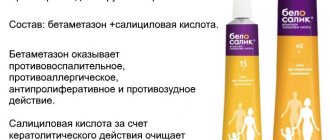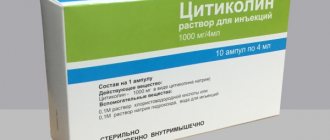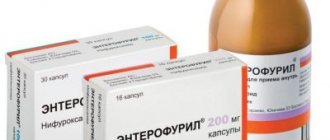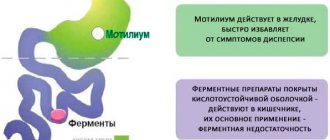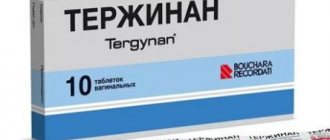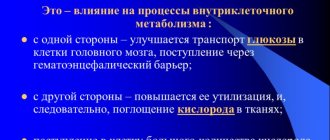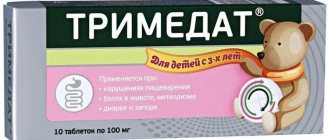pharmachologic effect
The mechanism of action of the drug is due to the combined composition. Thus, salbutamol is a selective stimulator of β2-adrenergic receptors, which helps to expand the lumen of the bronchi.
At the dose used in Ascoril (20 mg per 100 ml), it does not affect cardiac activity. Bromhexine hydrochloride reduces the viscosity of pulmonary secretions and promotes their discharge.
Guaifenesin stimulates the process of relaxation and cleansing of exudate from the bronchi, facilitating expectoration. Menthol eliminates symptoms of irritation and inflammation of the mucous membranes of the respiratory tract.
Compound
| Syrup | 10 ml |
| active substances: | |
| salbutamol sulfate (equivalent to salbutamol) | 2 mg |
| Bromhexine hydrochloride | 4 mg |
| guaifenesin | 100 mg |
| excipients: sucrose (sugar); sorbitol (70% solution); glycerol (glycerol); propylene glycol; sodium benzoate; citric acid monohydrate; sorbic acid; dye “Sunset” yellow (FCF); menthol (levomenthol); blackcurrant flavor (blackcurrant flavor ID20158); pineapple flavor (pineapple flavor super “PH”); purified water |
Indications for use and dosage
The instructions for use state that ascoril is indicated as part of secretolytic therapy for respiratory diseases accompanied by bronchospasm and the formation of viscous sputum, which is difficult to separate.
Such ailments include tracheobronchitis, bronchial asthma, pulmonary emphysema, cystic fibrosis, pulmonary tuberculosis, which is accompanied by the formation of sputum and attacks of suffocation, pleurisy, pleuropneumonia, bronchopneumonia, pneumoconiosis, whooping cough (with a clogging paroxysmal cough, sometimes turning into vomiting).
Ascoril is not an antibiotic, however, due to the salbutamol content, the drug should be taken as directed and under the supervision of a doctor, especially in pediatric practice.
For adolescents over 12 years of age and adult patients, the daily dose is 30 ml of syrup, divided into 3 doses.
For children from 6 to 12 years old, it is recommended that 15-30 ml of the drug be divided into 3 doses.
A more accurate dose is calculated by the doctor taking into account the child’s weight. Children from 2 to 6 years old – 1 tsp. 3 times a day.
The tablets are used in the treatment of children from 6 years of age and adults: over 12 years of age, a tablet is recommended 3 times a day, from 6 to 12 - 1 tablet. twice a day.
The duration of therapy is set by the attending physician, who will take into account the severity of the disease and its symptoms.
Contraindications and side effects
Ascoril is not used if there is a history of hypersensitivity to salbutamol and sympathomimetics, bromhexine and other main and auxiliary components of the drug.
It is also prohibited for patients with arrhythmia, severe cardiovascular pathologies, hyperthyroidism, liver dysfunction, gastric ulcer and/or duodenal ulcer, pregnant women and women during lactation to take the syrup.
According to reviews, when taking Ascoril, side effects may develop from:
- immune system in the form of rashes, skin itching, anaphylactic reactions, erythema multiforme, Stevens-Johnson syndrome, facial edema;
- Gastrointestinal organs: dyspeptic disorders, nausea, vomiting, diarrhea, pain in the epigastric region, exacerbation of gastric ulcer, unpleasant taste in the mouth;
- nervous system: tremor, myalgia, migraine, hyperactivity, insomnia, dizziness;
- cardiovascular system: tachycardia, heart rhythm disturbances, decrease/increase in blood pressure, myocardial ischemia;
- respiratory system: shortness of breath, increased coughing, paradoxical bronchospasm;
- convulsions, increased body temperature, constriction of the pupils, hypokalemia.
Interaction
Other beta2-adrenergic agonists and theophylline enhance the effect of salbutamol and increase the likelihood of side effects.
Ascoril expectorant is not prescribed simultaneously with drugs containing codeine and other antitussives, because this makes it difficult to clear liquefied sputum.
Bromhexine, which is part of the drug, promotes the penetration of antibiotics (erythromycin, cephalexin, oxytetracycline) into the lung tissue.
It is not recommended to use the drug simultaneously with non-selective beta-adrenergic blockers such as propranolol.
Salbutamol, which is part of the drug, is not recommended for patients receiving MAO inhibitors.
Diuretics and corticosteroids enhance the hypokalemic effect of salbutamol.
It is not recommended to take alkaline drinks simultaneously with the drug Ascoril expectorant.
List of analogues cheaper than Ascoril
Ascoril is available in two dosage forms:
- syrup, fl. 100 ml - 350 rub;
- tablets No. 20 - 375 rub.
Analogs of Ascoril, regardless of price, should provide the closest possible therapeutic effect. In any case, the doctor is required to select a similar drug.
Most often, it is recommended to replace the original Ascoril with medications such as:
- Erespal, syrup 2 mg/ml 150 ml – 250 rubles, tab. No. 30 – 425 rub;
- Ambroxol, sir. 100 ml (domestic manufacturer) – 120 rubles, tab. No. 20 – 50 rub.;
- Stoptussin, syrup - 250 rubles, tab. No. 20 – 199;
- Lazolvan, sir. 15 mg/ml, 100 ml – 210 rubles, tab. No. 20 – 165;
- Doctor Mom, sir. 150 ml – 165 rubles;
- Ambrobene, sir. 15 mg/ml 100 ml – 148 rub.
Cheaper structural analogues of Ascoril, which have an identical composition, include: “Kashnol” syrup (170 rubles), “Joset” syrup (185 rubles). These drugs are made in India, and their cost is significantly lower than the original.
Answers on questions
Ascoril for what kind of cough: dry or wet (wet)?
The medicine helps with a wet cough, as well as if the cough is dry, but the presence of viscous sputum is felt. Then the drug helps transform a dry cough into a productive one and removes phlegm.
Ascoril syrup or tablets – which is better for an adult?
Liquid dosage forms are better absorbed and begin to act faster. But not everyone tolerates the taste of syrups well. Some people find it more convenient to swallow a pill.
What substitutes are suitable for children
In pediatric practice, Ascoril is used exclusively as prescribed by a doctor, since in rare cases, paradoxical bronchospasm may develop as a side effect of the syrup.
The drug is prescribed to a younger group of patients with complicated bronchopulmonary diseases.
For a productive (wet) cough, the pediatrician, as a cheaper analogue of Ascoril for children, can prescribe “Ambrobene” (148 rubles) in the form of syrup, if the child does not have a history of allergic reactions, otherwise a solution for preparing a suspension is recommended.
In addition, the Russian "Ambroxol" (120 rubles), the Greek "Lazolvan" (210 rubles), the German "Prospan" (417 rubles), and the French "Fluditek" (378 rubles) are often prescribed. These drugs stimulate the thinning of mucus and facilitate its removal.
For dry, unproductive cough, medications that inhibit the cough center in the brain are indicated.
These include prescription syrup "Bronholitin" (121 rubles) as well as over-the-counter ones - "Stoptussin" (161 rubles) "Sinekod" (251 rubles)
To eliminate the spasmodic cough characteristic of whooping cough, Erespal is recommended (250 rubles).
Of the structural substitutes, the syrups used are “Joset” and “Kashnol” (170 and 185 rubles, respectively).
Ascoril or Lazolvan - which is better?
Lazolvan is a cheap analogue of ascoril, which has a different composition from the original product. Its main component is ambroxol hydrochloride, due to which the drug is prescribed as an expectorant and mucolytic agent.
The medicine also has a large number of release forms: syrup, solution for inhalation, lozenges, tablets, capsules, aimed at different age groups of patients. Ascoril is available only in the form of syrup and tablets.
Lazolvan is better suited for the treatment of bronchopulmonary diseases accompanied by cough with an uncomplicated course. Ascoril, unlike its analogue, thanks to its combined composition, is effectively used in the treatment of severe forms of such pathologies.
However, it also has a wider list of possible side effects and contraindications.
If necessary, simultaneous administration of Ascoril and Lazolvan is allowed for a faster onset of the therapeutic effect, but only as prescribed by the attending physician.
Askoril or Erespal
Erespal - similar in effectiveness to the original Ascoril. However, unlike it, it is a single drug containing fenspiride hydrochloride.
In this regard, erespal has significantly fewer contraindications for use and side effects occur less frequently, and it is much easier to tolerate by children.
The mechanism of action of the drugs is different. Thus, erespal exhibits an anti-inflammatory effect, prevents the formation of viscous secretions and blocks H1-histamine receptors, relaxing the smooth muscle tissue of the bronchi.
Ascoril stimulates the discharge of sputum. In this regard, it is more appropriate to prescribe Erespal for a prolonged cough with the formation of viscous sputum against the background of elevated body temperature, and Ascoril for a feeling of suffocation after coughing attacks.
Advantages of erespal:
- cheaper than the original;
- fewer contraindications and side effects;
- additional anti-inflammatory effect;
- more pleasant syrup taste.
Flaws:
- less effective for paroxysmal cough;
- course of treatment for at least 10 days (Ascoril, as a rule, is recommended to be taken for 5-7 days).
Efficiency of analogues and substitutes
The effectiveness of the drug depends on the diagnosis. If this disease is mild or moderate in severity, the effect of the drug occurs with a minimal course of use. In the presence of bronchial asthma, bronchitis, or severe pneumonia, an increase in dosage and course of treatment is required.
The most effective products are those containing many components, such as Ascoril. For example, Joset. Due to the large number of active ingredients, the risk of side effects increases and the range of contraindications is expanded. Therefore, doctors advise not to take risks, especially if the patient has problems with the cardiovascular system or digestive tract. They are prescribed Lazolvan, Ambrobene, and other drugs with a single component.
To understand how effective the product is after a course of use, laboratory and instrumental tests are performed. For example, bacteriological or virological analysis, chest x-ray, listening with a phonendoscope. If the remedy works, the cough gradually decreases, tests will show positive dynamics.
Doctors do not recommend long-term use of mucolytics. 5-7 days are enough to cause a positive effect. If treatment is continued independently by the patient, the sputum will become excessively liquid. It will flow down the bronchial tree, intensifying the disease.
Ascoril or Fluditec
Fluditec is the most similar substitute for ascoril, which has a different composition. The main component of the syrup is carbocisteine, which activates sialic transferase, which determines the complex effect of the drug:
- dilution of viscous sputum;
- an increase in the number of sialomucins, which inhibits the reproduction of pathogenic viruses;
- improving the structure and restoration of the mucous membranes of the respiratory organs;
- a decrease in the number of epithelial goblet cells, due to which secretion production is suppressed.
Just like Ascoril, Fluditec is not prescribed at the early stage of bronchitis or ARVI.
The drug is indicated for pneumonia, cystic fibrosis, bronchiectasis, that is, for a productive cough with heavy sputum discharge.
Fluditec additionally dilutes the contents of the paranasal sinuses, so it is prescribed in the complex treatment of sinusitis and sinusitis.
The advantage of Fluditec is also a smaller list of side effects and contraindications. The syrup can be taken for a long time, as prescribed in the instructions: for chronic bronchitis and bronchial asthma, up to 30 days.
Ascoril accumulates when taken for a long time and can provoke the development of dizziness, nausea, and vomiting.
The course of treatment should not exceed 7 days, so the syrup is prescribed to relieve symptoms caused by the formation and stagnation of a viscous secretion.
Due to the menthol content, ascoril exhibits calming, antispasmodic, and antiseptic activity. It should be taken in case of acute illness.
How to choose an analogue?
With the development of infectious and inflammatory diseases of the respiratory tract, bronchodilators and expectorants are used. Usually the drug has all these actions, since it consists of several active ingredients. Doctors often prescribe Ascoril. But some patients may experience side effects or have contraindications. An analogue is selected according to the following principles:
- a medicine of lower cost, produced by Russian manufacturers, therefore does not require additional production costs;
- other active ingredients that do not cause dyspeptic reactions, neurological disorders, local or systemic allergies.
To select an analogue, it is recommended to act independently. Even a pharmacist working in a pharmacy will not be able to accurately select a medicine that is suitable for a person. They turn to a therapist, infectious disease specialist, or pulmonologist to accurately select a remedy that causes an effect, but does not have a negative effect. One of the following medications is recommended:
- Erespal;
- Lorkof;
- Joset;
- Lazolvan;
- Ambrobene;
- Ambroxol.
Some people select an analogue depending on the form of release. For example, if Ascoril tablets are not suitable, they can use Lazolvan solution. It can be used both internally and as inhalation. The second option is easier to tolerate, without consequences.
When is Erespal needed?
Erespal is a syrup for oral use based on fenspiride hydrochloride. The active component eliminates the inflammatory reaction and expands the spasmodic bronchi. Mucus is liquefied and removed. Indications for use:
- pharyngitis, laryngitis;
- tracheitis, bronchitis, bronchial asthma;
- hoarse voice, cough that develops with diseases of the respiratory system;
- respiratory tract infections with cough in combination therapy with antibiotics;
- sinusitis, otitis media
Side effects develop with prolonged use. But they appear only in a small percentage of patients. Identifies the following negative consequences:
- vascular disorders in the form of tachycardia, arrhythmia, uneven heartbeat, decreased blood pressure;
- digestive tract disorder, dyspepsia, impaired stool formation (diarrhea or constipation), vomiting;
- local and systemic allergic reactions including urticaria, anaphylactic shock, angioedema.
The medicine is contraindicated for minor patients with individual intolerance. If side effects occur, stop use immediately. Do not wait for improvement, otherwise your health will gradually worsen. This is especially true for patients with heart disease, vascular disease, and stomach ulcers.
How is Joset effective?
Joset is a syrup with a combined effect. It occurs due to salbutamol, bromhexine, guaifenesin, menthol. When they influence the respiratory system, the following effects are formed:
- bronchodilator;
- expectorant;
- mucolytic.
The drug is used for bronchial asthma and bronchitis, emphysema, chronic obstructive pulmonary disease, bronchitis and tracheitis. It is prescribed in complex therapy for the treatment of pulmonary tuberculosis in order to remove sputum and not cause a secondary infection. Sputum is quickly eliminated and does not move down the respiratory system.
Adverse reactions include neuralgia, digestive disorders, increased heart rate, drop in blood pressure, and allergies.
The medicine has many contraindications for use. Among them are serious diseases of the cardiovascular system, diabetes mellitus, liver or kidney failure, stomach and duodenal ulcers, pregnancy, and lactation. If you use the product for a long time, guaifenesin will turn your urine pink. But this does not mean that bleeding has occurred in the urinary tract.
If you use an excessively large amount of the drug, an overdose will occur. Symptoms include increased side effects. Symptomatic therapy is carried out.
How is Lazolvan useful?
Lazolvan is a solution for internal and inhalation use. The release form is selected depending on the severity of the disease. Contains ambroxol hydrochloride. Due to it, the production of pulmonary surfactant increases, mucociliary clearance increases, and sputum discharge is facilitated. It quickly liquefies and is discharged outside. The sputum does not go down, so complications of the disease do not form.
It is necessary to observe the dosage and course of application, since it is possible to liquefy the sputum, which will lead to flow down the bronchial tree.
The medicine is indicated for use in acute and chronic bronchitis, pneumonia, chronic obstructive disease, bronchial asthma, bronchospasm. Side effects are rare. Among them are the following phenomena:
- indigestion, abdominal pain, sore throat;
- disturbance of taste sensations;
- local and systemic allergic reactions in the form of urticaria, rash, anaphylactic shock, angioedema, itching of the skin.
The drug is contraindicated during pregnancy, lactation, and in children under 6 years of age. Due to the auxiliary components, it is not recommended for persons with fructose intolerance. Before purchasing, it is better to read the instructions for use. If the patient has an individual intolerance to one of the components, the drug should not be used.
Ambrobene for cough treatment
Ambrobene is a solution for oral administration or inhalation. It is produced on the basis of ambroxol hydrochloride. The solution has both a mucolytic and expectorant effect. When the active ingredients enter the body, they cause the following reactions:
- improvement in the properties of sputum, it becomes less viscous, and is quickly removed from the bronchi and trachea;
- stimulation of the activity of serous cells in the bronchial glands, which produce enzymes to break down the bond between secretion polysaccharides;
- the onset of the therapeutic effect within 30 minutes after taking the first dose, it lasts 6-12 hours.
The drug is indicated for use in acute and chronic bronchitis, pneumonia, bronchial asthma, bronchiectasis. It is used to stimulate surfactant production in premature infants. If they are born before 36 weeks, there is a risk of elemental deficiency, which causes lack of breathing.
If used by inhalation, the drug is applicable for bronchitis, pneumonia, asthma, bronchiectasis.
Side effects occur in the digestive system and immune system. Nausea, vomiting, and impaired stool formation are possible. Local and systemic allergic reactions occur less frequently. The drug is contraindicated for stomach and duodenal ulcers. It is not used for epilepsy or individual intolerance.
Ambroxol for thinning mucus
Ambroxol is a medicine in syrup form. Its base is ambroxol hydrochloride. It has the following pharmacological effects:
- mucolytic
- liquefaction of thick secretions, which are more easily excreted through the bronchial tree and trachea; - expectorant
- removal of liquefied sputum.
Thanks to the drug, serous cells of the bronchial mucosa are stimulated. The motor activity of the ciliated epithelium increases. It is easier to remove phlegm.
Additionally, the product enhances the production of surfactant, which improves the respiratory function of the lungs.
The drug is indicated for use in acute and chronic diseases of the respiratory tract. These are bronchitis, pneumonia, bronchial asthma, bronchiectasis, chronic obstructive pulmonary disease. Interestingly, the medicine is sold in the form of solutions for intravenous administration. If you use it, the indications for use expand. Additionally, the drug is used for newborns with an insufficient amount of surfactant in the lung tissue.
There are many side effects. Among them are local and systemic allergic reactions, dyspeptic disorders, neuralgia, inflammation of the skin and subcutaneous tissues, and dry mouth. The drug is contraindicated in case of individual intolerance, pregnancy, children under 6 years old in tablets or 12 years old in capsules.
Ascoril or Ambrobene
The main component of ambrobene is ambroxol hydrochloride. Since the composition of the drugs is completely different, such a replacement is possible only on the recommendation of the attending physician.
Also, thanks to the combination of medicinal substances, the original medicine has a much wider range of indications than Ambrobene.
When using Ascoril, bronchodilator spasms are suppressed, especially at night. In addition, the capacity of the lungs increases, making breathing easier and the removal of viscous secretions.
Ambrobene stimulates the production of serous cells, which increases the amount of sputum. It becomes less viscous and comes off easier.
The advantages of ambrobene are lower cost, fewer contraindications and rare development of side effects.
Disadvantages include the lack of bronchodilator action, a narrower list of indications and a weak therapeutic effect.
Ascoril or Joset - which is better?
Joset is an inexpensive structural analogue of ascoril. The main components of the syrups are identical, as are their dosages, the only difference is in the auxiliary components.
The list of indications, possible side effects, and established contraindications is also similar.
Like the original Ascoril, Joset is used in pediatric practice from the age of 2, strictly under the supervision of a doctor. The duration of therapy is determined by the established diagnosis.
However, unlike askoril, a similar joset is produced only in the form of a 100 ml syrup. That is, for an adult patient, one bottle for a course of treatment is not enough, so therapy can cost even more than the cost of Ascoril.



